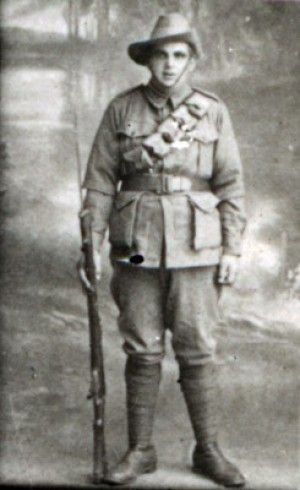Service Details
- Branch of Service
- Army
- Conflict
- World War I (1914-1918)
- Date of Enlistment
- 05/12/1915
- Place of Enlistment
- Goulburn NSW
Personal Details
- Gender
- Male
- Date of Birth
- 27/12/1891
- Place of Birth
- Annandale NSW
- Address (at enlistment)
- Canberra ACT
- School(s) Attended
- Gungahleen [Gungahlin] Half-time School
- Occupation
- Road contractor employed by the federal government at the gravel pit, Duntroon
- Next of Kin
- Son of Mrs Charlotte Ellinor Harris of North Sydney NSW, brother of Eva, Frederick and Mina Potter. George Potter became a State Ward and was raised by Mrs Mary McDonald (nee Mathieson and formerly Shumack) of 'Hawthorn Cottage', Upper Canberra.
- Burial Place
France 511 Peronne Communal Cemetery Extension
Unit and Rank Details
- Service Number
- 5434
- Final Rank
- Lance Sergeant
- Final Unit
- 53 Battalion AIF
Fate
Died (killed in action) near Peronne on 1 September 1918 aged 27 years
Commemoration
AWM Roll of Honour Memorial Panel 158, Canberra ACT
Large stone tablet on outside of northern wall of St. John's Church, Reid ACT
Stained glass window in St Ninian's Presbyterian (now Uniting) Church, Lyneham, dedicated to his memory on 19 September 1948 by the Moderator-General of the Presbyterian Church
Roll of Honour at St. Stephen's Presbyterian Church, Lowe Street, Queanbeyan NSW
World War 1 Memorial, corner of Lowe St and Farrer Place, Queanbeyan
Queanbeyan RSL Wall of Remembrance, Crawford St, Queanbeyan
Notes
George Potter was actually born George Bate on 27 December 1891 at the Sydney Benevolent Asylum, a site long since occupied by Central Railway Station. Bate was his mother's maiden name and, although she had married a man named Potter in 1884, George's father is unknown. George and his older brother and younger sister returned to the Benevolent Asylum in early 1897 and afterwards became wards of the State and were fostered by Mary McDonald who lived at 'Hawthorn' in Upper Canberra. George grew up at 'Hawthorn', went to Gungahleen School and helped run Mrs. McDonald's dairy. He also became involved in local sporting organizations, building courts for the Ainslie Tennis Club on part of 'Hawthorn' and joining the Ainslie Cricket Club when it was formed in 1914.
He waited until several months after the death of Mary McDonald to enlist on 5 December 1915. He and Michael Scannell were listed as the executors of her estate, although Scannell was serving on Gallipoli at the time so the task fell to George to complete. He was lucky to make it overseas - after one of his farewell parties he was being driven in a buggy which tipped over and crashed at Ginns Gap. He survived and joined the 53rd Battalion in France at the end of July 1916 but was hospitalised with a broken nose in November 1916. He participated in the 5th Division's campaigns at Flers and Gueudecourt in the winter of 1916, and on the Bapaume-Cambrai road, at Bullecourt and Passchendaele during 1917 and was appointed as a Lance Sergeant at the end of that year. He was wounded in the arm near Villers-Bretonneux in April 1918 but returned to his unit four months later.
At the end of August 1918 the 2nd Division assaulted Mont St. Quentin, a hill overlooking the walled town of Péronne on the Somme River. The 5th Division were given the task of capturing the town but first the 53rd Battalion had to clear the road to Péronne. As they advanced, Potter's company was faced by German machine guns firing from behind several unbroken belts of wire and a barrage of shells. The only way through the wire was a gap where the road to Péronne passed through. "Men died like flies there and we faltered", wrote his Company Sergeant Major, Clarrie Burns, "but old George Potter firing burst after burst from the Lewis gun at his hip silenced a nest of German machine-guns and enabled us to stream through the narrow inlet." Potter was the main figure in the attack and became the focus of the German machine guns, sacrificing himself for the sake of his fellow soldiers.
Among those from the 53rd Battalion who made it through the gap in the wire was William Currey who in the following hours would earn the Victoria Cross. The 5th Division would go on and capture Péronne and Potter was later buried in the town's cemetery. For years after the war those members of his unit, who owed their lives to his courageous and selfless action, would drink a silent toast to his memory at reunions. It is believed that Potter was the closest resident to the site of the future Australian War Memorial at the time he enlisted.
Description - height 5 feet 10½ inches, weight 205 pounds, chest 40 inches, dark complexion, grey eyes, black hair, Church of England.
Sources
AWM Roll of Honour Database
AWM Roll of Honour Circular
First World War Unit Embarkation Rolls
A.W. Bazley, 'Gallant Lewis gunner', Stand-to, vol. 4, no. 4, Jul-Aug 1954 (p.24)
Rex Cross, 'Bygone Queanbeyan', 1980
Stories from the ACT Memorial, 'Ainslie Challenges the Kultur Club', ACT Heritage Library www.library.act.gov.au/find/history/stories_from_the_act_memorial
Stories from the ACT Memorial, 'The Road to Peronne', ACT Heritage Library www.library.act.gov.au/find/history/stories_from_the_act_memorial
Sydney Benevolent Asylum - www.sydneybenevolentasylum.com/
Queanbeyan Age - 28 March 1916, 31 March 1916, 4 October 1918
Our Queanbeyan 'Boys' No.2, Howard & Shearsby, Yass (postcard)
NAA RecordSearch - Series B2455 (First Australian Imperial Force Personnel Dossiers, 1914-1920)
